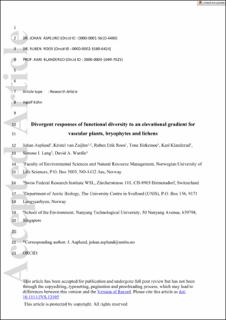| dc.description.abstract | Question: Cold environments are stressful for vascular plants, and stress-tolerant non-vascular photoautotrophs, e.g. bryophytes and lichens, become relatively more important as competition from vascular plants decreases towards higher elevations. Under increasingly stressful climatic conditions, species assembly of vascular plants is commonly driven more by environmental filtering, and abiotic constraints may lead to increased similarity between species and thus low functional diversity. Because bryophytes and lichens are less constrained by harsh environments, environmental filtering may be less strong. Instead, reduced competition from vascular plants can potentially free up niche space for non-vascular vegetation. Therefore, we hypothesized that functional diversity of vascular plants, bryophytes and lichens are likely to show contrasting responses to elevation. Location: Finse Alpine Research Centre, Southern Norway. Methods: We utilized measurements of species abundance and functional traits of the three groups along a 500-m elevational gradient in alpine southern Norway and calculated multi-trait and single-trait functional dispersion. Results: Functional diversity of vascular plants declined with elevation, indicating increased environmental filtering. By contrast, functional diversity of lichens and bryophytes increased along the same gradient, suggesting they are less exposed to environmental filtering, in line with our hypothesis. Instead, they likely benefit from the lower abundance of vascular plants at higher elevation. Conclusions: Our findings suggest that different photoautotroph groups vary in how they respond to the same environmental gradient, which may contribute to contrasting community assembly processes across groups. These divergent responses likely occur because non-vascular vegetation differs from vascular plants in terms of nutrient acquisition and water economy strategies, meaning that they respond differently to the same factors. This highlights the need to explicitly consider bryophytes and lichens in community-level studies whenever these groups are abundant. | |
